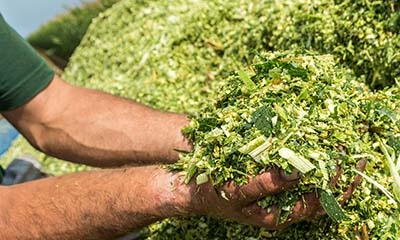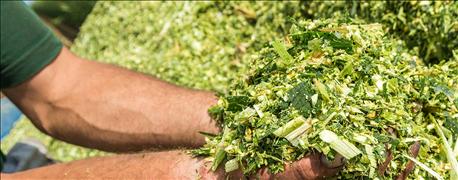October 18, 2016

Producers should be on the lookout for corn smut with the wet fall conditions. Affected crops can still be used for silage.
“While producers may see a drop in corn yields due to smut contamination, the crop is still valuable and can be successfully ensiled,” says Renato Schmidt, Ph.D., Forage Products Specialist, Lallemand Animal Nutrition. “The fungus that causes smut does not itself produce toxins, and studies in sheep have shown it does not affect feed intake.”

Corn contaminated with smut can be used for silage, but using an inoculant is recommended. (Photo: oticki/Thinkstock)
Corn smut is caused by the growth of Ustilago maydis, which thrives in conditions of high humidity, poor pollination or damage from insects or equipment. Once the plant is infected, the fungi’s cells divide quickly and expand. This leads to large gray galls that contain black spores, typically on the corn ear tip.
The resulting galls decrease grain yield anywhere from 9% to 40%. When fed, Ustilago maydis can affect feed efficiency. Feed digestibility also can be reduced when infestation levels reach 50% or greater. Research shows total digestible nutrients (TDN), net energy for maintenance (NEM) and net energy for gain (NEG) values of corn silage decreased around 0.5%, 0.02 mcal/g, and 0.02 mcal/g, respectively, for each 10% rise in smut-infested plants.
When corn contaminated with smut is ensiled, the disease also can restrict the rate and extent of fermentation and predispose the plant to further mold growth and the production of mycotoxins, Dr. Schmidt warns.
“Corn contaminated with smut can still be used for silage, but we strongly recommend using an inoculant that is research-proven to help drive a fast, efficient initial ensiling fermentation and inhibit the growth of detrimental spoilage microbes during feeding,” Dr. Schmidt advises. “This can help keep the silage stable.”
Specific bacteria strains and enzymes can help address these ensiling challenges. Producers should look for an inoculant containing the lactic acid bacteria Pediococcus pentosaceus 12455 — fueled by sugars generated by high activity enzymes — to help promote a fast, efficient front-end fermentation. To address challenges during feedout, an inoculant containing the high dose-rate Lactobacillus buchneri 40788 can help improve the aerobic stability of silage.
In fact, the specific strain, Lactobacillus buchneri 40788 — when applied at 400,000 CFU per gram of silage or 600,000 CFU per gram of high-moisture corn (HMC) — is the only inoculant bacteria strain reviewed by the FDA and allowed to claim improved aerobic stability, based on independent trials.
“Silage made from corn contaminated with smut also is likely to be more variable than normal,” Dr. Schmidt says. “Be sure to have samples analyzed regularly — at least once a month — so adjustments to the ration can be made as necessary.”
Source: Lallemand Animal Nutrition
You May Also Like




